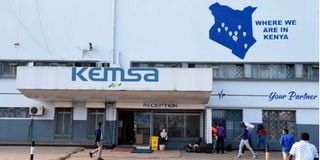Kemsa banks on new system to monitor procurement processes

The Kenya Medical Supplies Authority (Kemsa) Head Office Nairobi at Commercial Street, Industrial Area, Nairobi on February 11, 2022.
What you need to know:
- The State agency will adopt the use of the Enterprise Resource Planning (ERP) system that will ensure orders, budgets and supply chain are easily monitored by the click of a button.
- The system links all other systems and departments together creating end-to-end visibility and strengthening accountability and reporting at all levels of the supply chain.
Kenya Medical Supplies Authority (Kemsa) is banking on technology to automate its procurement and payment processes minimising human interventions.
The State agency will adopt the use of the Enterprise Resource Planning (ERP) system that will ensure orders, budgets and supply chain are easily monitored by the click of a button.
Kemsa chief executive officer Ms Terry Ramadhani said ERP creates open, transparent and accountable systems that will make it easy to track procurement processes.
As part of ongoing reforms at the government agency, she explained that the system links all other systems and departments together creating end-to-end visibility and strengthening accountability and reporting at all levels of the supply chain.
She pointed out that the ERP, which will start being piloted in October before a full rollout in December this year, introduces the ability for each department to communicate with each other, see what is going on in terms of orders, stock flow, what finance is available in terms of budget, and distribution.
“The system helps in bringing visibility at all levels minimising the risks of not being able to see what the left hand is doing,” said Ms Ramadhani.
“We will never have a situation where people get local purchase orders (LPOs) by the roadside. We will be very focused on making sure the systems and processes work,” she added.
Seamless flow
The Kemsa boss said the new development will ensure entry and flow of commodities is seamless and they do not end up with deadstock but only commodities needed by their clients.
Further, it will safeguard against committing to supplies which have not been budgeted for ending up not paying suppliers.
“Before approving an LPO, there must be a budget line and money approved so that we don’t end up in a situation where we commit our suppliers to bring in supplies that we don’t have money to pay for yet they have delivered,” she said.
She pointed out that since coming in in May, they have been re-engineering all manual processes leading to significant improvement in order fulfilment rate as well as reducing turnaround times.
For instance, turnaround time has been reduced to less than eight days as of July 2022 from 40 days in May 2021, while the order fulfilment rate has gone up to 70 per cent from 43 per cent.
“It is our hope that we can get to the one-day turnaround time for critical items, five days for referral hospitals and seven days for public primary health care facilities.”
Ms Ramadhani added that the Authority has also adopted a new organisational structure featuring redefined roles and functions aimed at improving the agency’s performance as well as boosting its operating efficiencies.
The redefinition of functions, she said, has the merger of some departments and the functional repurposing of roles to align them to the Kemsa new strategic plan dubbed 2.0.
Personnel restructuring
The personnel restructuring will see staff establishment capped at 378, new job descriptions, and clarity of roles to eliminate duplicities, among other changes.
“Kemsa reforms are anchored on a three-pronged transformation strategy focusing on operational excellence, enhancing customer experience and repositioning the organisation,” said the Kemsa boss.
“Even with technology, without an accountable workforce then you cannot achieve much as the human face is always the weakest link,” she added.
Overall, in the last financial year, Kemsa dispatched Sh27 billion worth of essential medicines and medical supplies to more than 8,768 health facilities countrywide.
Another Sh1.38 billion was spent on supplying nutritional supplements alongside essential medicines to drought-hit counties including Kilifi, Marsabit, Samburu, Baringo, Garissa and Tana River.
Stakeholder engagements saw the government agency unlock Sh2.7 billion in pending bills from counties with Makueni, Kilifi, Nakuru, Laikipia, Nyeri, Meru, West Pokot, Turkana and Kisii clearing their debts.





